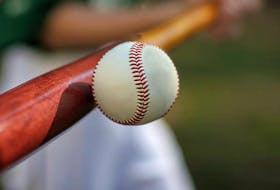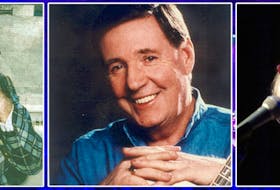Lost in Newfoundland
with photographer Michael Winsor
Breakwater Books
$29.95
As an artbook, this volume, “Lost in Newfoundland” is itself a little work of art.
Fronted with a luminously-hued hard cover, the pages inside aren’t numbered, but altogether it makes a nice rectangular heft that fits neatly in the hand.
And it doesn’t hurt that that cover image is Michael Winsor’s view of an iceberg in Ferryland, drifting past Newfoundland and Labrador’s vernacular architecture of sheds and boats, which achieved global renown.
But to backtrack a bit: Winsor has conceived this book as “an artistic compendium” and “a fine art homage.”
In his introduction he explains the title: “I’ve often found myself lost in Newfoundland. Not literally lost in the sense of being unable to find my way, but lost in the grandeur of a sweeping seascape or the rugged magnificence of a landscape. Lost in the hypnotic stare of a red fox or in the sheer power of a humpback whale. I’ve looked through a camera lens and been lost in a quality of light that only seems to occur here.”
Winsor grew up on Pool’s Island, Bonavista Bay. He spent a lot of time outdoors, occasionally fished with his grandfather, and in the winter went into the backcountry for firewood, “difficult work for a boy, but those trips always provided a cook-up and the best cup of tea one could ask for. My father always said those spruce needles and tree twigs were the source of that extra flavour.”
Winsor hopes his photographs are steeped in such culture, conveying the atmosphere, carrying the dynamics of excursions and chores, the hints of some fiddle music, ocean salt, a crescent moon.

“I grew up here, but I never really saw Newfoundland until I held a camera in my hand,” he writes.
And his sightings fill the rest of the book, an album of full-coloured photos, either a duet of images or single one laid out over a two-page spread, all offset with brief italicized captions. There’s an Atlantic puffin in noble solitude; then a trio of three stand apace, one checking out the camera. Or a yellow spectrum of the Bonavista lighthouse. Or a northern gannet curled into itself, beside clouds over Gros Morne Mountain.
I find it interesting, gladly so, that photography is still so popular, when most of us can take a half-decent shot with our phones. It seems human nature to like looking at pictures. And nature photography, with a subgenre of landscape photography, especially appeals with its tendency to skew towards the idyllic (i.e. unpeopled).
In his play with depth of field, Winsor sometimes allows faraway objects to blur, and other times keeps everything sharp as a tack. The historic Ryan Premises, for example, “framed by night sky and blue water,” is all crisp definition, to the fence pickets and telephone poles, with the street lights in flare and the reflection furred.
Focal points draw the eye and indicate scale, like the small white boat and pinpoint stars under and behind the green-white curtains of an Aurora Borealis. Other pieces are foregrounded by a slew of rocks or a field of dandelions.
Skies sometimes take up two-thirds of the composition, as in “Shooting stars and the grandeur of our galaxy above Fogo Island,” which is an astounding array (and if that wasn’t enough, underscored with an iceberg).
It’s a truism that there are no straight lines in nature, but the hull of a boat, roof of a shed, or silhouette of a mountain lend delineation, contour and perspective.
Focal points draw the eye and indicate scale, like the small white boat and pinpoint stars under and behind the green-white curtains of an Aurora Borealis. Other pieces are foregrounded by a slew of rocks or a field of dandelions.
A photograph freezes time, but holds movement, in the rush of Atlantic tide, a stream of chimney smoke caught in a change of wind direction, flocks of birds (“A group of puffins is sometimes called a circus. A group of murres is known as a bazaar.”)
Views of Newfoundland can be all about weather — even our Anthem is all about weather — and the four seasons are represented here along with all they can bring, in a natural palette which expands to Port de Graves’ Christmas boats.
Often the golden hour, what filmmakers would call the magic hour, infuse such pieces as the Ferryland iceberg.
Horizons configure the imagery: one third, one half, three fourths, calibrated from the photographer’s point of view.
There are adventurous fauna sightings, like a swimming polar bear, a stalking lynx, or an alert bald eagle.
Other highlights include the lacey monochrome of Bowring Park, “after the first snowfall of December,” the bridge and trees demarcated with a scrim of white flakes.
Lots of beguiling finds in getting lost.
Joan Sullivan is editor of Newfoundland Quarterly magazine. She reviews both fiction and non-fiction for The Telegram.









